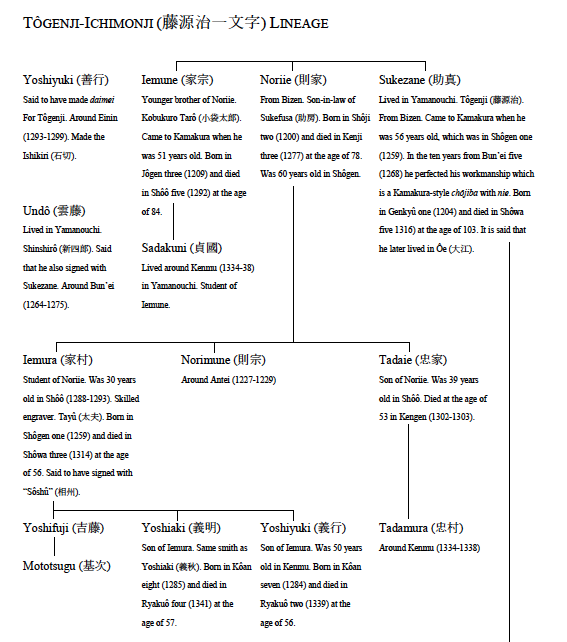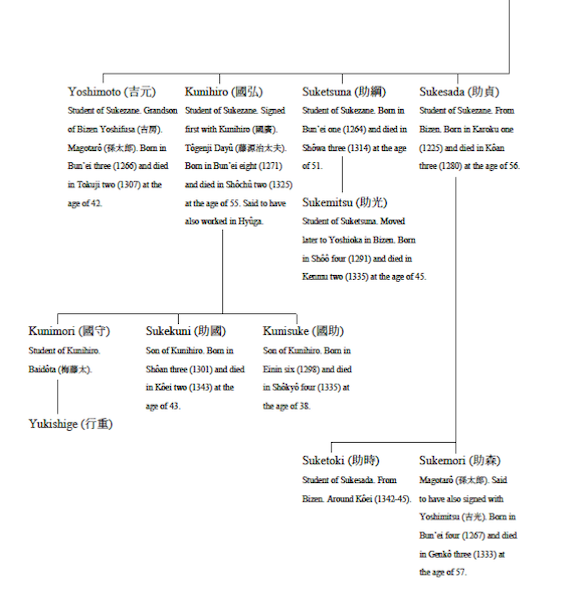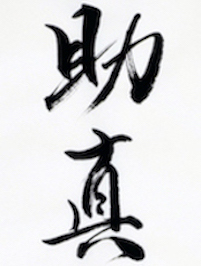
The Ichimonji School in Bizen Province was founded in the early Kamakura (1185–1333) period. It was the largest school, in terms of the number of successors, and maintained this status until the late Nanbokuchō (1334–1392) period. The smiths of this school who worked from the early to the mid Kamakura period were collectively called Ko-Ichimonji (古一文字). The school’s manufacturing center was located in Fukuoka. It is generally accepted that the founder of the Fukuoka Ichimonji (福岡一文字) School was Norimune (則宗), whose works date back to the Jōgen era (承元, 1207–1211). Norimune bore the honorary title of Gyōbu no Suke (刑部丞) and was ranked first on the Gotoba Goban-Kaji (後鳥御番鍛冶) list. Emperor Gotoba (後鳥羽天皇, 1180–1239) drew up this list, a register that included the names of the twelve smiths who replaced one another to cover each month of the year, while working to create an ideal sword.
Norimune’s tachi are considered the finest and most elegant of all the Ichimonji School swords, having a narrow sugata with ko-kissaki and a deep koshizori. In the mid Kamakura period, his closest successors in the Fukuoka Ichimonji School, who included Yoshifusa (吉房), Norifusa (則房), Sukezane (助真), Yoshiie (吉家), Sukefusa (助房), and others, gradually developed a slightly different style of their own. This style featured a more pronounced and “stronger” sugata with larger and more closely arranged twists of chōji-hamon (o-chōji-midare).
According to Fujishiro Yoshio (藤代義雄), Sukezane (named Tōgenji [藤源次] at birth) was the son of Sukefusa (助房) or, according to other sources, the son of Sukenari (助成). The book Kotō Meizukushi Taizen (古刀銘盡大全), by Ōgi Iori Sugawara Hirokuni (仰木伊織菅原弘邦), tells us that Sukezane was born in the 1st year of the Genkyū era (元久, 1204) and died in the 113th year of his life in the 5th year of the Shōwa era (正和, 1316). His work span is thought to be from the Kenchō era (建長, 1249–1256) to the Bun’ei era (文永, 1264–1275); that is, it generally covers the period from 1249 to 1275.
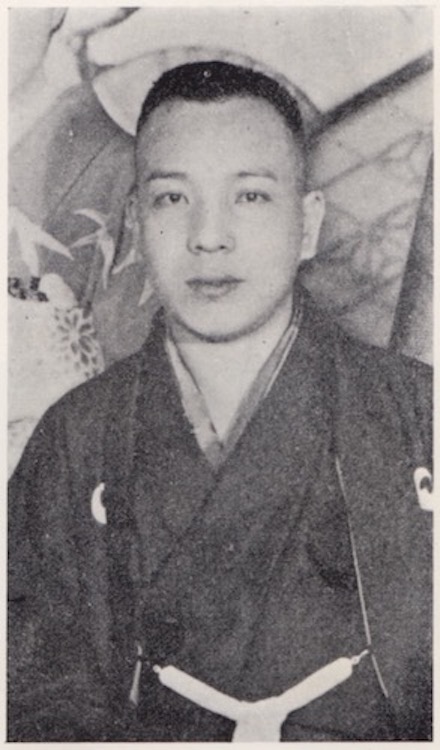
Figure 1. Fujishiro Yoshio.
Kokon Kaji Bikō (古今鍛治備考) by Yamada Asaemon Yoshimitsu (山田浅右衛門吉睦) published in 1830 states that Sukezane lived in the Kantō region (関東地方)—that is, in Tōtomi (遠江) Province, as well as in one of the districts of Kamakura named Yamanouchi (山ノ内). The master’s only works that have survived to date are long swords (tachi and katana), and not a single tantō is extant. Even old books do not feature tantō oshigata made by Sukezane (with very rare exceptions, as in Figure 1.1). Therefore, it is quite possible that this master manufactured only long swords—his unique specialization, so to speak.
Many masters of the Ichimonji School signed their work with the “Ichi” (一) kanji, without indicating the name of the smith who manufactured it. This is generally believed to be a display of pride for one’s school and a demonstration that the smith valued belonging to the school above publicizing his personal name. However, certain masters, such as Yoshifusa, Norifusa, and Sukezane (often collectively referred to as “Fukuoka Ichimonji Sansaku”), sometimes added their smith’s name after the “Ichi” character. Yet most of Sukezane’s works are signed with just two characters: “Suke” and “Zane” (助真). No swords with the “Ichi” character placed before Sukezane’s signature have survived until our time. Only old oshigata (“whole sword or tang drawings”) have survived, which can be found, for instance, in Kōzan Oshigata (光山押形), but they hardly allow us to determine the swords’ authenticity.
Dr. Honma Junji (本間順治), pen name Kunzan (薫山), considers a feature of the Sukezane sword to be a chiseled signature made of two large kanji. This feature, in combination with ō-sujikai yasurime, a signature in the katana-mei style, and the use of a wide mihaba in the sugata, renders his works somewhat untypical of the Bizen Ichimonji style. That is why some experts occasionally consider an alternative viewpoint on Sukezane’s origin, namely, that he came from Tōtōmi Province (遠江国), as set out, for example, in a source from 1381, Kiami-bon Mei-zukushi (喜阿弥本銘尽). Regarding Tōtōmi Province, some sources show that Sukezane moved there later—that is, on the completion of his work at Kamakura. This point of view can be found in the book Kokon Wakan Banpō Zensho (古今和漢万寶全書), written by Kukimoto Kyōhosai in 1694 (Volume 11 [2], p. 61/2; 1694), and in other sources.
Sukezane’s style and manner of writing the characters in his signature remained almost unchanged, despite the fact that he relocated his residence and started to experiment, using in his works the best techniques of other schools. Sometimes we see a signature made with smaller kanji. Such a signature is believed to be characteristic of a later period in his career. However, in order to absolutely correct compare the signature size, one should know the initial blade length and the width of the nakago before shortening. Among a fairly large number of swords attributed to Sukezane, few specimens are signed, while the signed ones lack dates. That is why it is rather difficult to determine the period of the master’s creative activity, since even the old oshigata give no evidence that he ever dated his work.
Thus, based on old sources and the works that have reached us, we can conclude that during his initial period of activity in Fukuoka, Sukezane signed his name as “Ichi Sukezane” (一助真). Later, in the middle of his creative period, he used two large kanji, “Suke Zane” (助真), and by the end of this period, he signed with the same but smaller characters. In addition, the Kōzan Oshigata shows a version of his signature as “Suke Zane Saku” (助真作), which the master also used at some stage of his career.
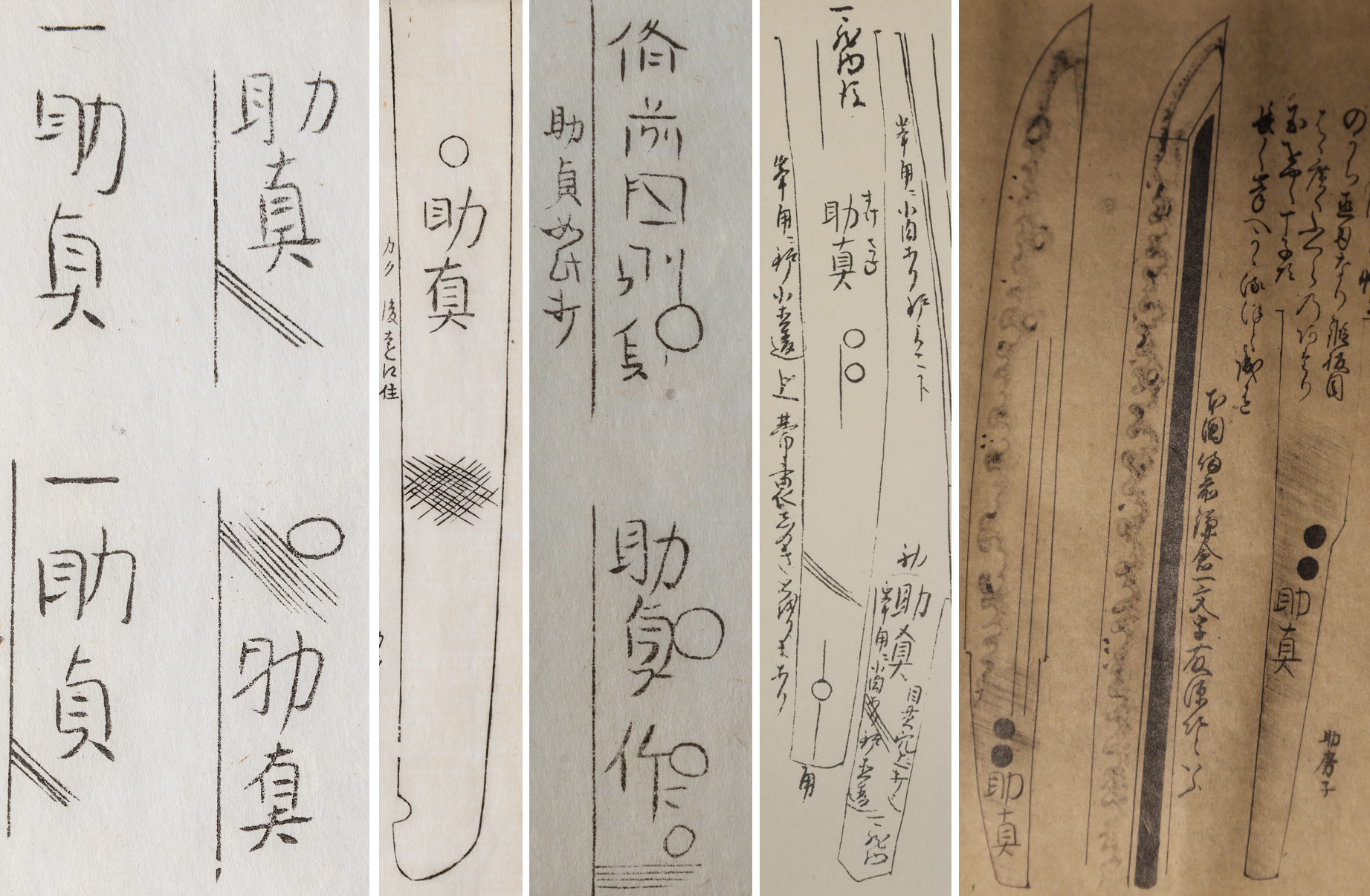
Figure 2. Samples of Sukezane’s signature, Kotō Meizukushi Taizen, Volume 9, p. 12/2; Volume 8, p. 24/2; Volume 9, p. 12/2 and Ōseki Shō, reprint of 1978, p. 98.
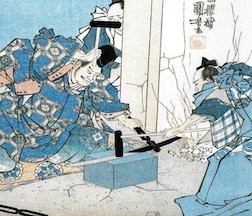
Sukezane’s works have the following distinguishing features:
Sugata: Tachi are made in the style of the middle Kamakura period, featuring a strong koshizori with a slight narrowing from the machi to the kissaki; they had no large hira-niku, but a ha-niku.
Jitetsu: The steel structure is as follows: a rather large-structured but well-forged itame-hada that is mixed with mokume-hada; sometimes we can see ō-mokume-hada and the presence of chikei and midare-utsuri. The steel is whitish but has a bluish shine.
Hamon: In most cases, a combination of midare-chōji and jūka-chōjiu, along with a nie-based hamon, demonstrating small-sized grains of nie along short, shiny lines of kinsuji. There are inazuma, deep nioi, and ashi along the cutting edge. The hamon is a wavy pattern that may reach the shinogi. Nioi-deki is seen in the works made in Bizen, and nie-deki in the works made in Kamakura.
Bōshi: Usually, the midare-komi continues along the tempering line; the hamon in the zone of the bōshie ends with a yakizume or with a small kaeri; sometimes, there are hakikake and inazuma.
Nakago: Long with a bend, sometimes kijimomo (雉子股); frequently, the tang does not taper much toward the tip. The tip of the nakago is kiri-jiri; the yasurime are usually sujikai; the name is written in two spacious kanji and with a thick chisel. There are no dated works. Larger characters refer to the earlier style.
Horimono: Either bō-hi or futasuji-hi, but both are rarely present.
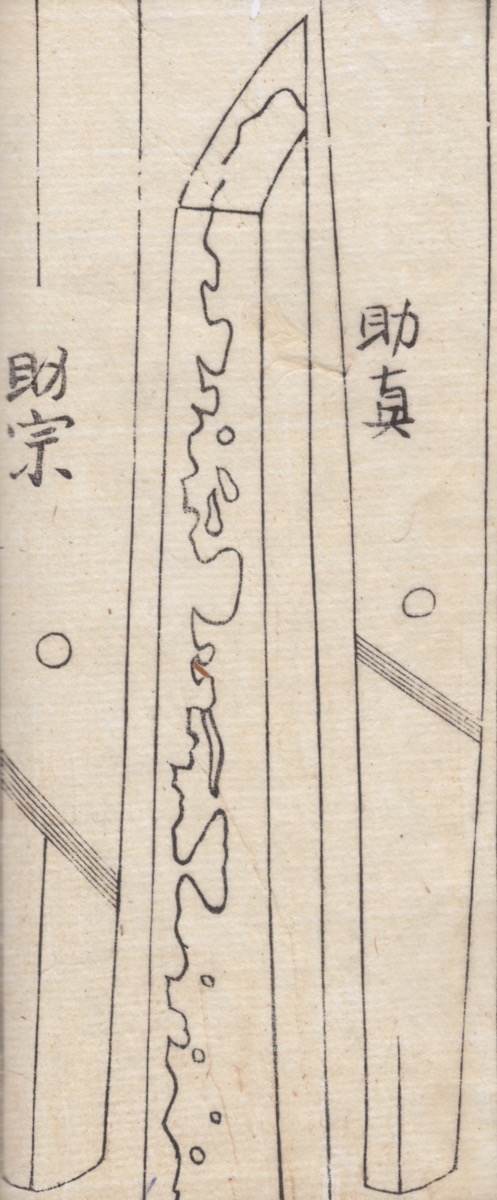
Figure 3. Sukezane's elements of activity layout. Kokon Meizukushi Taizen, vol. 5, p. 29/2.
(excerpt from Chapter 1, pp.12-25, of the Japanese Swords: Sōshū-den Masterpieces )
Original content Copyright © 2019 Dmitry Pechalov
Supplement to Chapter 1 of the Japanese Swords: Sōshū-den Masterpieces book
As of today (according to renewed statistics), 43 swords are known (Jūyō and above) to be Sukezane’s work. There are no “weak,” inexpressive works among them, which is proved by the large number of swords with the highest possible status. Of all his works known to us, 2 swords (tachi) have Kokuhō status; 9 swords (6 tachi and 3 katana) are Jūyō Bunkazai; 11 swords are Tokubetsu Jūyō Tōken; and 13 are Jūyō Tōken. Another 8 swords (3 tachi and 5 katana) were awarded Jūyō Bijutsuhin status in their time. Interestingly, as of now, none of those items have received NBTHK titles. Few of those works are signed: only 19 from all categories, plus 3 Jūyō Bijutsuhin swords.

Figure 4. Sukezane's works statistic data.
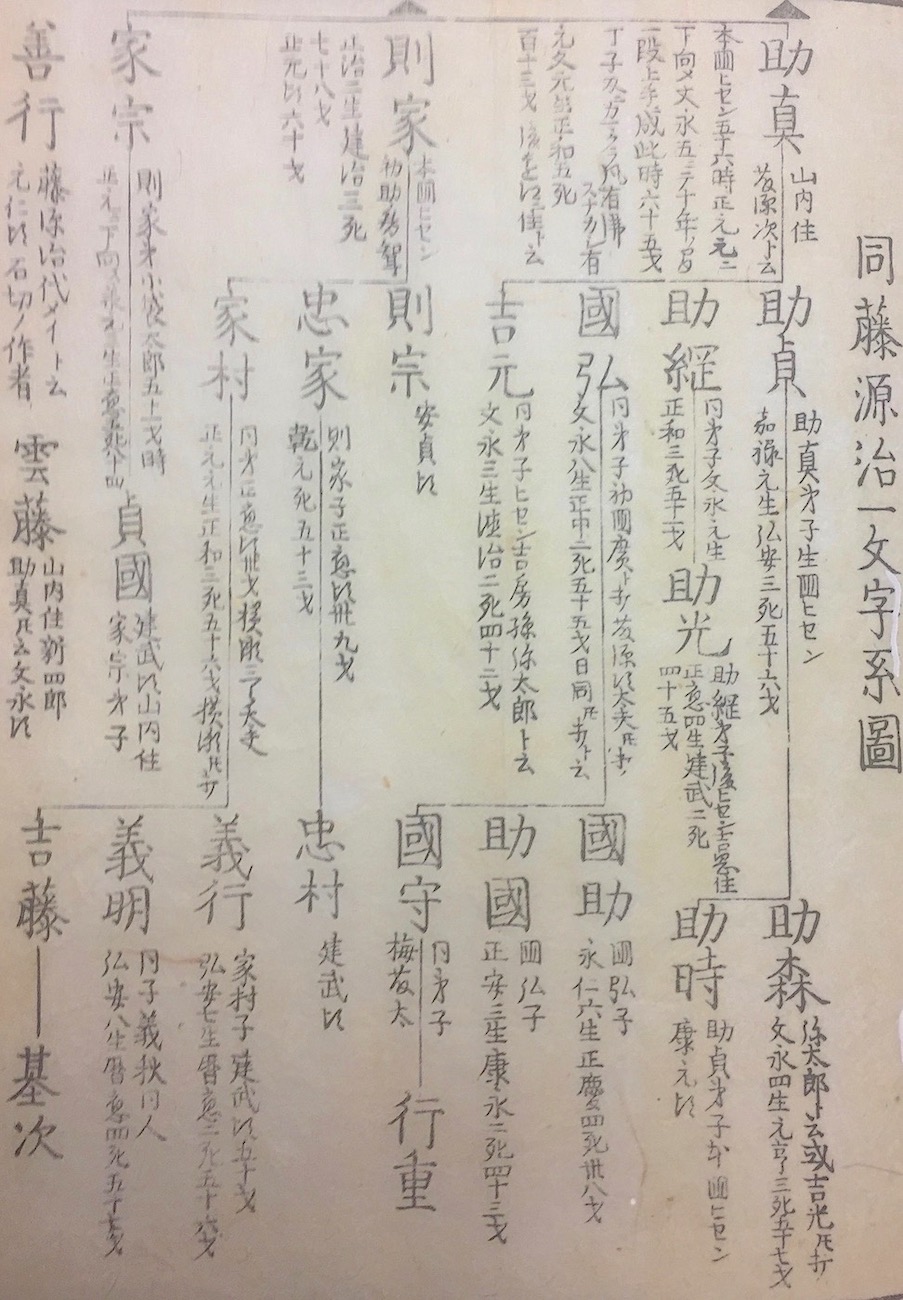
Figure 5. Genealogy of the Tōgenji-Ichimonji School's masters. Kotō Meizukushi Taizen, 1792, vol. 2, p. 13/1.
